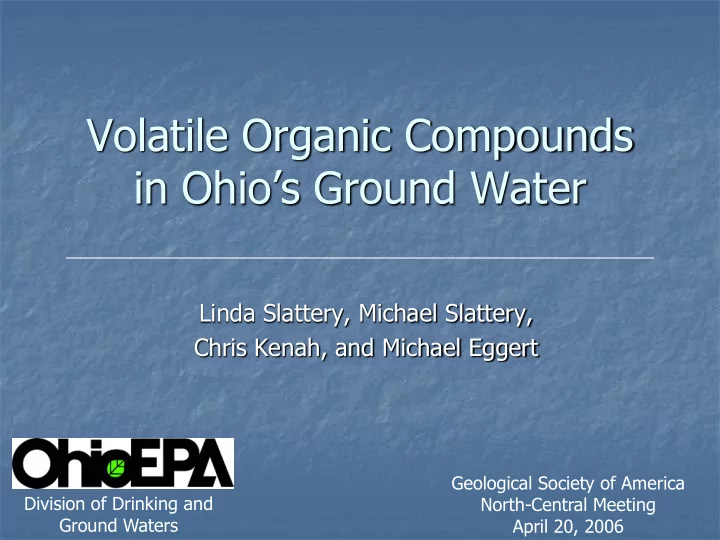

Volatile Organic Compounds in Ohio’s Ground Water Linda Slattery, Michael Slattery, Chris Kenah, and Michael Eggert Geological Society of America Division of Drinking and North-Central Meeting Ground Waters April 20, 2006
Ground Water in Ohio ~6 million people rely on ground water (~50 %) Over one billion gallons of ground water per day is used for people, industry and farmers. Major Aquifer Types in Ohio
VOC Data Sources Public Water System Compliance Data - ~2,000 PWSs routinely sample for regulated VOCs - Post-1991 - Treated ground water - n ≈ 380, 000 - Sampling frequency = monthly to every 3 years Ambient Ground Water Monitoring Data - ~ 200 active wells sampled for 61 VOCs (EPA 624) - Post-1985 - Untreated ground water - n ≈ 84,000 - Sampling frequency = once every six to 18 months
Data Filter* Two confirmed results of same or related compound constitutes a VOC impact THMs: PWS removed, Ambient retained *Approach identical to SWAP data censoring for Susceptibility Analyses
Sensitive Aquifers Geologic settings 1 : sand and gravel deposits/aquifers bedrock aquifers below thin till or thin lacustrine deposits (thin < 25 ft) 1 ODNR-Division of Water, 2000. Glacial Aquifer Map (digital format)
Sensitive Aquifers Community and NTNC PWSs: 56% (1,107) are within sensitive aquifer settings - 10% (109) have VOC impacts - 4% in non-sensitive settings have VOC impacts Ambient Stations: 72% (146) are within sensitive aquifer settings - 16% (23) have VOC impacts - 3% in non-sensitive settings have VOC impacts
Nitrate Nitrate and VOC impacts: Average Casing Length = 51 ft Average Total Well Depth = 86 ft VOC impacts only: Average Casing Length = 69 ft Average Total Well Depth = 139 ft - Possible geochemical association
Percent Land Use in SWAP Areas located in Sensitive Aquifer Settings Land Use PWSs w/ PWSs w/ No VOC Impacts VOC Impacts Commercial Industrial 4% 10% Transportation Residential 12% 19% Agricultural 61% 49% Land use data obtained from 1994 USGS National Land Cover Dataset
Summary VOCs most likely detected in sensitive aquifers Population density and urban land use directly related to VOC impacts Nitrate is not a good indicator of VOC occurrence VOCs require a point source Deeper wells more likely to exhibit reducing conditions Solvents most frequently detected Chloroform commonly detected in untreated wells
Future Work Evaluate details of impacted vs. non-impacted wells to better define associations Evaluate point source data 2006 305(b) Report on GW Quality Ground Water Impacts database
Acknowledgements GIS assistance: Dave White and Bridget Simpson For more information… Web address www.epa.state.oh.us/ddagw/wqcharpr.html Email address gwq@epa.state.oh.us
Recommend
More recommend